Introduction
The onset of the global COVID-19 pandemic in early 2020 forced all EU governments to implement restrictive measures, with social distance playing a key role. Many businesses were temporarily closed and many employees were sent home and isolated to prevent the virus from spreading. Hence, the health crisis has had a significant impact on economic life and the labour market. The blockade and other health-related measures have led to a slowdown in economic activity. During this period, some people lost their jobs, several jobs were blocked, the number of unemployed people increased, some unemployed people stopped looking for work in conditions of uncertainty and employers reduced their work schedule. The poverty rate has risen as a result of declining incomes, and the GINI index of wage inequality has risen higher.
In most EU countries, governments have approved nominal and real increases in the legal minimum wage for 2020-2021. These increases will have a positive effect on reducing some of the wage inequality resulting from the crisis. In particular, the minimum wage will have a relatively stronger impact on groups such as young workers, immigrants and women (Molina, 2021).
Despite the unusually harsh economic and labour market conditions, most EU Member States have registered nominal and real increases in minimum wages in 2020. Some countries have kept their previous promises or pre-agreements, while other countries have moved away somewhat from their original path, but still maintained the general trend of increasing minimum wages in line with other wages. Although most countries have been cautious about the level of growth granted, the low inflation rates have pushed the value of minimum wages further beyond consumer price increases. For the time being, at least, it can be concluded that the wage policy response in the context of the COVID-19 pandemic is different from the approach during the 2007-2008 global financial crisis, when more countries acted swiftly to freeze nominal minimum wages.
The minimum wage is considered an important element of public policies aimed at reducing poverty and income inequality. Increasing the minimum wage is supposed to lead to an increase in the income of low-wage workers and, consequently, to a decrease in income inequality. At the same time, the minimum wage can influence the labour supply through the unemployment rate. Moreover, COVID-19 context changed a lot the way people react to changes and insecurities and this is why it is very important for the states to set a suitable minimum wage mechanism in order not to negatively impact the way in which society is evolving.
Having these into consideration, we decided to investigate in this paper the labour market performances of the EU member states in the context of the COVID-19 pandemic through the use of the following macroeconomic indicators: unemployment rate, poverty rate, GINI coefficient, the minimum wage and the ratio of total COVID deaths over total confirmed cases. A cluster analysis was, thus, carried out for the year 2020 among the EU countries that have implemented the minimum wage. Our results reveal that some imbalances in labour market and welfare variables may negatively affect the COVID death rate.
The structure of the paper is the following: Section 2 is dedicated to a brief literature review in the field, while the clustering methodology and the data are described in Section 3. The main results of the paper are discussed in Section 4, while the last section concludes.
Literature Review
The uncontestable truth is that the Coronavirus crisis poses a threat to the European economy and the living standards of its citizens. During this health crisis, it is important to protect not only the critical sectors of the economy, but also assets, technology, infrastructure, and, most importantly, jobs and workers.
Minimum wages play an important role, both as an adjustment mechanism and in helping economies to recover and regain their place on the path to inclusive economic and social growth (Guga, 2021). The minimum wage is an indicator that can reduce some of the inequalities induced by the COVID-19 crisis. Increases in the minimum wage can adjust income inequalities, can reduce the unemployment rate, especially among vulnerable groups – young people, women, immigrants, and implicitly can help reduce the poverty rate.
Setting a minimum wage in the labour market is never an easy task, but it is an even more daunting exercise in times of crisis. The COVID-19 pandemic has had an impact on economies and labour markets around the world: suddenly, severely and almost simultaneously. However, some sectors and workers were much more affected than others. Low-wage workers in the EU27 have been the hardest hit by the crisis, losing more working hours than better-paid managers and professionals, according to the International Labour Organization’s report on global wages for 2020-2021 (ILO, 2021).
The dilemma for decision-makers to maintain the purchasing power of the low-wage earners at a high level and provide them with an adequate wage, while protecting jobs and businesses – is not a new one, but has been aggravated and accelerated during the pandemic crisis. The minimum wage decision-makers faced the determination of the minimum wage level for 2020 in the context of difficult economic conditions, declining wage pressure due to higher unemployment and great uncertainty about the economic projections for the coming periods. In addition, the pandemic has led to disruptions in the normal negotiation and consultation processes.
Obviously as a result of the spread of the COVID-19 pandemic, many countries have initiated social distancing policies to slow the spread of the virus, in order to avoid catastrophic outcomes for the national health systems and reduce the number of human deaths. In the case of the labour market, many millions of workers have been directly affected by the measures taken by each country. Strong and unforeseen reductions in economic activity have led to a dramatic drop in employment, both in terms of the number of jobs and the hours worked. In this global context, underemployment is also expected to increase significantly. Thus, in-work poverty is likely to increase significantly. The pressure on incomes resulting from the declining economic activity will most affect those workers who are already close to, or even below, the poverty line.
The COVID-19 pandemic has caused all employees worldwide to suddenly experience significant changes, both in the family and in their professional activity, the most affected being low-wage workers without access to social protection. ILO (The International Labour Organization) and other international bodies have developed a series of scenarios based on the available data to obtain an image of the impact of COVID-19 on the global labour market. Thus, in the three scenarios of declining GDP, by 2%, 4% and 8% respectively, the number of unemployed people increases on average by 5.3 million people, 13 million people and 24.5 million people respectively (Albu et al., 2020).
The COVID-19 crisis has had effects on the labour market, by increasing the unemployment rate, especially among young people, income inequalities and, implicitly, the poverty rate. The ILO experts group the necessary measures to combat the effects of COVID-19 on the economy on 4 pillars: Stimulating the economy and employment; Supporting businesses, jobs and income; Protecting employees at work and Initiating dialogues to find solutions. On the other hand, social protection measures must aim at: effective access of all people to health services; supporting jobs and securing the incomes of those affected by the crisis; efforts to prevent poverty, formal and informal unemployment; ensuring economic and social stability and peace; activating strong economic and social stabilizers (ILO, 2020).
Tan et al. (2021) conducted a study at the USA level that correlated income inequality at the American state level, measured by the Gini coefficient, and the number of COVID-19 cases at the state level and the number of deaths in the United States at different time periods from 2020 and 2021. The results showed that the prevalence of cases and deaths caused by COVID-19 was disproportionately higher among socially marginalized communities, exacerbated by income disparities and implicit access to health services. At the same time, it is considered that a potential mechanism that explains the stronger association between COVID-19 cases and Gini coefficients is that individuals with lower incomes in states with higher income inequality may have a higher risk of COVID-19 infection because of the economic pressure to remain in high-risk jobs. Many who are at high risk for COVID-19 cannot work from home. People on lower incomes tend to work in sectors that produce non-transferable goods, such as restaurants, hotels or entertainment venues, which require person-to-person contact.
The labour market has been severely affected by the pandemic, and the recovery process will be slow. Job losses have exacerbated global inequality, with women, young people and informal sector workers being the hardest hit. On the current trajectory, as the labour market begins to recover, there is a major risk of accentuating inequality. There is a strong recovery and fairly good prospects for people in high-income countries and jobs for highly qualified specialists. In the context of the current COVID crisis, unemployment does not show the real impact on the labour market, the real, much harder, impact is represented by the reduction of the work schedule in most countries of the world. Today, while full-time employment has resumed in the US, many Europeans remain stuck in the category of part-time employees (Robalino, 2020).
Another key issue to consider in relation to the wage impact of the COVID-19 pandemic crisis is wage inequality. Given that the sectors that have been most affected by the social distancing measures and the lack of mobility are often labor-intensive and low-wage sectors, the asymmetric impact of the COVID-19 crisis can be translated into an increase in wage inequality. The crisis has had a greater impact on lower paid workers than on other workers. If we take into account the higher wage increases reported in the public sector, a general increase in inequality will be inevitable in the next period.
Methodology And Data
We focused on clustering the European Union countries by significant labour market indicators, in the context of the Covid-19 pandemic. The k-means clustering method was applied using RStudio.
K-means is an unsupervised clustering method which involves grouping the analysed objects from the data set into several clusters, each cluster containing a set of objects from a certain category. From a technical perspective, the method first involves an a priori establish of the centres of each cluster. Afterwards, the method determines for each object the nearest cluster centre and so the object is considered to belong to that cluster. The following step is to determine those clusters for which the centres become stable. Hence, the centre of each cluster is recalculated in order for it to represent the position minimizing the distances to cluster objects. Once all the clusters’ positions are recalculated, the distances to each object are determined again and the objects are accordingly regrouped. The algorithm resumes until the cluster centres become stable.
The reason why k-means algorithm was chosen for this particular analysis is related to the fact that this method is usually used to group observations into homogenous clusters without a prior knowledge of the relationships established between the variables for each record. Broadly speaking, the algorithm is one of the straightest forward grouping techniques, being commonly used in different research fields.
Our analysis is based on a set of labour market indicators among the European Union member states. The chosen period refers to 2020 and the data were mostly retrieved from Eurostat and official COVID-19 data related websites like Worldometer or ourworldindata.org. A short description for each variable considered in the analysis is presented in the table below.
Table 1: Variables taken in the analysis
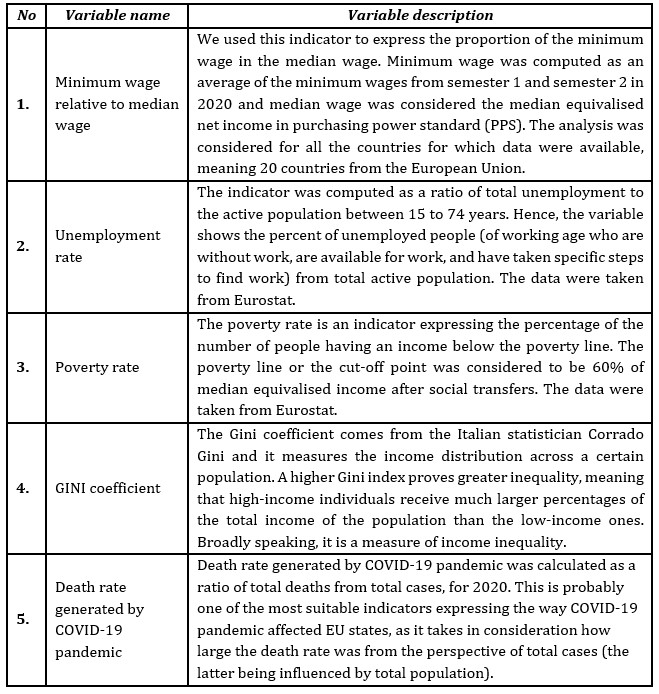
The analysis started by taking into consideration all EU member states. However, in the research phase, some member states were excluded from the initial data set either because they do not have yet a statutory minimum wage level established by law or no data were available yet. Thus, the data set consists in twenty EU countries for which all the variables considered were retrieved from official data sources (Eurostat or other COVID-19 data websites like Worldometer or ourworldindata.org) or calculated, as described above.
As per the current analysis, we consider that it is of high importance to first analyse the data through descriptive statistics. It is the oldest theoretical root of statistics included in the so-called statistical practice in universities in the sixteenth and eighteenth centuries, when the quantitative, numerical description of the countries’ population, army, soil wealth, productive and commercial activities has significantly amplified. As a definition, we may consider that descriptive statistics do represent the branch of statistics allowing the easy understanding of the events’ characteristics (Mooi et al., 2017).
Using the summary() function in R, we first checked the basic statistics regarding maximum and minimum values, the first, second and third quartiles, grouped by each analysed variable.
As per the aforementioned definition and the output from above, the 75% of the minimum wage per median wage is under 0.68 and the maximum unemployment rate is 16.3, corresponding to Greece. Also, 25% of the poverty rate is under 13.75 and the median corresponds to 17.15, meaning that 50% are having a poverty rate larger than 17.15 and the other half under this value. As per the GINI coefficient, the minimum value corresponding to Slovakia is 20.9. On the other hand, the maximum value corresponds to Bulgaria. From the COVID-19 deaths rate perspective, the average is around 0.02 among European Union countries implementing a minimum wage.

Figure 1. Descriptive statistics of the data set
Secondly, this article will underline the importance of cv() function computing the coefficient of variance. Its purpose is to express the ratio between the sample standard deviation and the sample arithmetic average, as a percentage. By the exclusion of the measurement unit, the coefficient of variation enables the comparison between multiple datasets. Among the five variables which are analysed within this article, the maximum dispersion of the distribution is related to unemployment rate and minimum one does correspond to GINI coefficient: 15%.
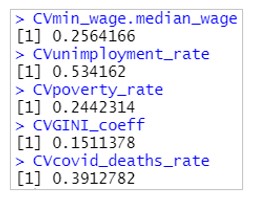
Figure 2. Coefficient of variance per the analysed dataset
Regarding the unemployment rates registered in 2020 in the European Union member state, the most unfavourable positions were faced by Greece (16.3%), Spain (15.5%) and Italy (9.2%). These findings come as no surprise, as these countries have also been strongly affected by the Great Recession in 2008 and were already dealing with significant indebtedness problem ever since. Since these three countries rely mainly on labor-intensive activities, like tourism, they were quite severely hit by the COVID-19 pandemic crisis, as shown by the number of COVID-19 deaths and by the financial losses registered in the affected economic sectors.
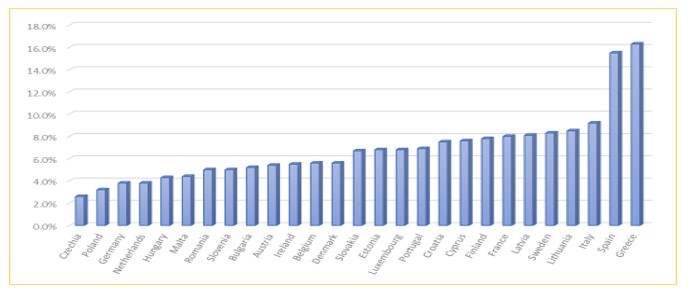
Figure 3. The unemployment rate in the EU countries in 2020
The situation of the EU countries in terms of poverty rate for the year 2020 is somewhat different, as it places the Baltic countries and the two South-Eastern countries – Romania and Bulgaria along with Italy and Spain, among the countries with higher poverty rates above the EU average.
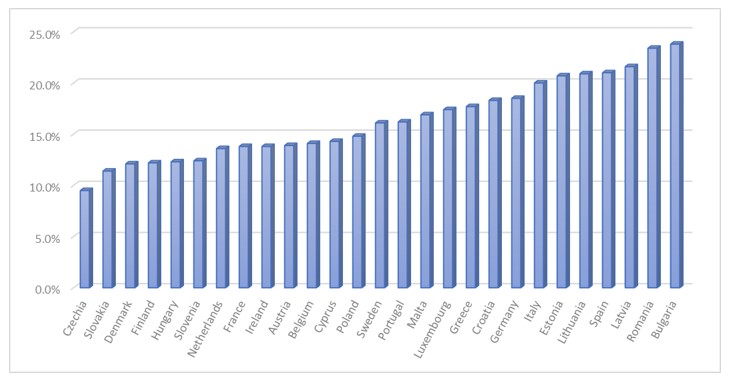
Figure 4. The poverty rate in the EU countries in 2020
In terms of COVID-19 deaths registered in the European Union in the year 2020, the hardest hit countries were by far once again Greece and Italy, alongside with Bulgaria, where the COVID-19 deaths rate was the highest (of about 0.0375).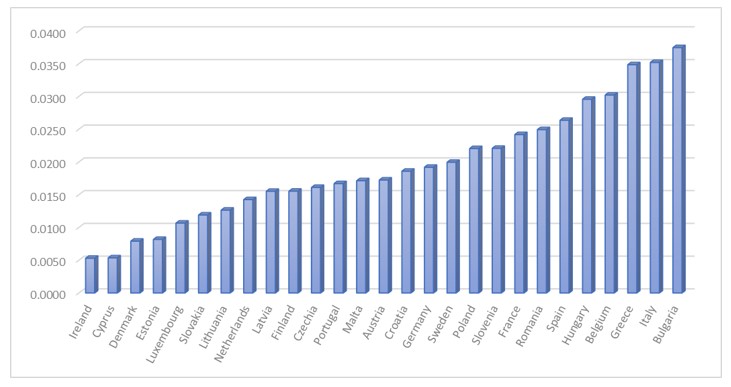
Figure 5. The COVID-19 deaths rates in the EU countries in 2020
COVID-19 deaths rates above the EU average were also noticed in Belgium, Hungary, Spain, Romania, France, Slovenia, Poland and Sweden. At the opposite side, the least affected EU countries by the COVID-19 pandemic in terms of death rates were Ireland and Cyprus with less than 0.006 values registered in 2020.
Main Results
The cluster analysis was performed using RStudio open-source software for desktop and the results are based on applying k-means clustering method on the dataset described above, data being previously centred and the number of clusters set to five.
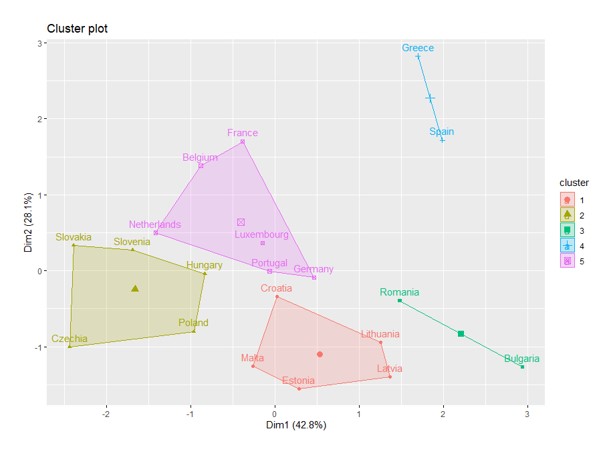
Figure 6. Clustering EU countries having the minimum wage implemented
We obtained five groups of countries, as per below:
- Cluster 1 (Red): Estonia, Lithuania, Latvia, Malta and Croatia;
- Cluster 2 (Green): Romania and Bulgaria;
- Cluster 3 (Blue): Greece and Spain;
- Cluster 4 (Purple): Luxembourg, Portugal, Germany, Netherlands, Belgium, France;
- Cluster 5 (Yellow): Slovenia, Slovakia, Hungary, Poland, Czechia;
As per cluster 1, it seems to be formed by Baltic countries group to which Malta and Croatia were added. If we look over the data used to generate this group, we can notice that the minimum wage relative to median wage indicator does have similar values, in the following interval: [0,45 – 0,59]. Also, the poverty rate is around 19-20 precents, except Malta having almost 17 precents poverty rate.
Cluster 2 is being formed by only two countries, Romania and Bulgaria respectively. We notice that for both countries the unemployment rate is around 5 precents and poverty rate around 23 precents, meaning that we can expect for these two countries to feel the same way the impact generated by the COVID-19 crisis. Also, the covid deaths rate is not significantly different, Romania having around 2% and Bulgaria around 3%. Both countries are part of the Eastern European Area and have the highest poverty rate of all the countries which were subject to the analysis.
Cluster 3 consists in two countries which seem to be outliers in the dataset. As we can notice from the k-means plot from above, the cluster does consist in only two countries and is being positioned at a noticeable distance from the other clusters. Spain and Greece are, in the analysed context, outliers, having the unemployment rate almost double comparing all the other countries. The dimensions from the plot are highly influenced by each variable, as the number of variables analysed is not very large. Hence, the amount of the unemployment rate impacts a lot the way the plot is generated and the positions of these two countries.
Cluster 4 does contain the greatest number of countries: Luxembourg, Portugal, Germany, Netherlands, Belgium, France. An a priori conclusion would be that for sure these countries indicators’ level is almost the same. As we look over the data, we notice that the report of minimum wage and median wage is closer to one for these six countries, meaning that the minimum wage is not that different from the median wage the population receives.
There are five countries generating cluster 5, namely: Slovenia, Slovakia, Hungary, Poland, Czechia. As per the considered data, we can notice that the countries, four out of five countries from the cluster, do have the lowest poverty rate of the EU countries and all the five countries are in the first ten EU countries from a GINI coefficient perspective in 2020.
Conclusions
This article aimed to be a starting point for analysing how the COVID-19 outbreak has placed the states of the European Union, also considering some other economic indicators like poverty rate, unemployment rate or minimum wage. In this worldwide context where everything is new and very hard to predict, the impact is both on the employers and employees and so it is on labour market. It is of high importance for the policy makers to know the countries with which a particular state has something in common and to carefully observe the decisions and politics applied there. In this way, we may learn one from another and we may take suitable decisions and regulations. The nature and independency of job opportunities is constantly changing and things like technological progress, inequality income, globalisation and ageing populations are continuously reshaping the way labour markets behave.
The cluster analysis we conducted in the article highlighted three groups of countries with similar effects at the group level and two other groups that differ by higher values of some indicators included in the analysis.
There is a group of countries with high values of the minimum wage compared to the median wage (Belgium, France, the Netherlands, Germany, Luxembourg and Portugal). We note that, with the exception of Portugal, we are talking about the group of continental European states, in which unemployment and poverty rates are below the EU average. With the exception of France and Belgium, the COVID death rates in this group are among the lowest in the EU. We could say that states with higher incomes, but also with a more pronounced equality (lower GINI coefficient) determine a greater capacity to implement risk reduction strategies in case of a pandemic crisis and greater access to health services before and after the pandemic (see Tan et al., 2021).
The Baltic countries, Estonia, Latvia and Lithuania, stand out in a separate group alongside Croatia and Malta. Within this group, even if the values of the minimum wage-median wage ratio are the lowest, the COVID-19 death rate is the lowest in the EU, as a result of the implementation of stricter restrictions on travelling abroad. At the same time, the Baltic countries are the first to create the first “travel bubble” through which citizens and residents of these countries can move freely within the borders of the Baltic area, but with restrictions outside of it. This measure was seen as an opportunity to reopen business and a ray of hope for people that life is back to normal.
Following the analysis, a group of countries with good values of labour market indicators (low rates of unemployment, poverty and GINI coefficient) and with average values of the COVID-19 death rate were also outlined. That is the group of Central and Eastern European countries, the Czech Republic, Poland, Hungary, Slovakia and Slovenia, countries that managed to recover economically and socially in the COVID-19 pre-crisis years, which allowed them to act quickly on the effects of the pandemic, and thus, not to affect the well-being of the population.
Following the clustering, a group formed by Romania and Bulgaria was highlighted as a result of the registration of the highest poverty rates at the European level, given that unemployment rates are below the EU average. COVID death rates are also quite high, especially in Bulgaria where the rate is the highest in the EU countries included in the analysis. At the same time, the highest value of the GINI coefficient is registered in Bulgaria, a situation that supports the fact that income disparities can be positively associated with the risk of infection and COVID-19 deaths (see Tan et al., 2021).
The group of countries formed by Spain and Greece is highlighted by very high values of unemployment rates, especially among young people. Practically, these countries have failed to recover their job losses from the previous economic crisis of 2007/2008, and the pandemic crisis has affected them even more in this segment of the labour market. Poverty rates are also high, especially in Spain, and the COVID death rates are also among the highest in the countries under analysis.
The analysis carried out in this article highlighted that regardless of the economic status of the country (developed or emerging), if there were imbalances in the labour market (minimum wage, unemployment, income inequality, poverty) and COVID death rates were higher, we could practically say that there is a link between material well-being and the negative effects of COVID virus infections.
These issues are important in order to implement appropriate measures at the EU level to avoid or mitigate the effects of a pandemic crisis that is still present on the European continent.
Acknowledgment
Part of this work was supported by the NUCLEU Program funded by the Romanian Ministry of Research, Innovation and Digitization (Project PN 19130202).
References
- Albu, L.L. – coordinator, (2020), ‘Evaluări ale impactului macroeconomic al COVID-19’, Romanian Academy, Institute of Economic Forecast, available at: https://academiaromana.ro/SARS-CoV-2/doc/d08Impactul_macroeconomic_al_COVID-19.pdf
- Gagu, Ș. (2021), ‘Minimum salary and minimum decent leaving: From myths to opportunities, Friedrich-Ebert-Stiftung and Syndex’, available at: https://library.fes.de/pdf-files/bueros/bukarest/17786.pdf
- ILO Monitor 1st Edition, (2020), ‘COVID-19 and the world of work: Impact and policy responses’, 18 March 2020, available at: ilo.org
- ILO, (2021), ‘Global Wage Report 2020-21’, available at:https://www.ilo.org/global/research/global-reports/global-wage-report/2020/lang–en/index.htm
- Mooi, E., Sarstedt, M., & Mooi-Reci, I. (2017). Descriptive Statistics. Market Research, 95–152.DOI:10.1007/978-981-10-5218-7_5
- Molina, O. (2021), ‘Impact of the COVID-19 crisis on wages and wage setting’, Eurofound – European Foundation for the Improvement of Living and Working Conditions, available at:https://www.eurofound.europa.eu/publications/article/2021/impact-of-the-covid-19-crisis-on-wages-and-wage-setting
- Robalino, D., A., (2020), ‘The COVID-19 Conundrum in the Developing World: Protecting Lives or Protecting Jobs?’ IZA DP No. 13136, available at: https://www.iza.org/publications/dp/13136/the-covid-19-conundrum-in-the-developing-world-protecting-lives-or-protecting-jobs
- Tan, A., Hinman, J., Abdel Magid, H., Nelson, L., Odden, M. (2021), ‘Association Between Income Inequality and County-Level COVID-19 Cases and Deaths in the US’, JAMA Netw Open. 2021;4(5):e218799. doi:10.1001/jamanetworkopen.2021.8799, available at:https://jamanetwork.com/journals/jamanetworkopen/fullarticle/2779417










